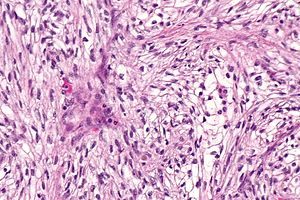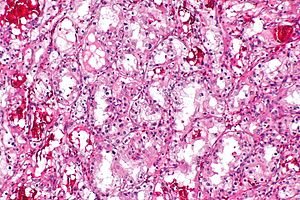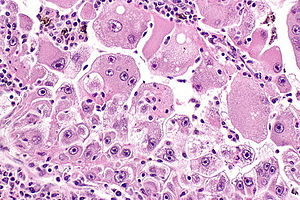Renal cell carcinoma grading
Jump to navigation
Jump to search

ISUP nucleolar grade 4 is used for renal cell carcinoma with sarcomatoid differentiation. H&E stain.
This article deals with renal cell carcinoma grading.
Fuhrman grading, ISUP grading, ISUP nucleolar grading and kidney cancer grading redirect here.
General
There are two systems:
- Fuhrman grading:
- Older and more complicated.
- Based on nuclear size and shape, chromatin pattern and nucleolar size.[1]
- ISUP grading:[2]
- Newer and less complicated.
- Mostly based on nucleolar size and to a much lesser degree on size and morphology
- Developed based on Fuhrman grading.
- Validated in other independent cohorts.[3]
ISUP grading
Criteria:[2]
- Grade 1 - nucleoli absent/very small at 400x. §
- Grade 2 - nucleoli seen with 400x, but not at 100x. §§
- Grade 3 - nucleoli seen at 100x, i.e. with the 10x objective.
- Grade 4 - extreme nuclear pleomorphism (esp. nuclear enlargement) or sarcomatoid differentiation (spindle cells[4] or rhabdoid cells).
Cavets:[2]
- Higher grade component trumps lower grade component.
- No agreed upon minimum quantity of high grade component for upgrading.
- 37% use 1 field of view with the x10 objective. †
- 41% use 1 field of view with the x40 objective. ‡
- No agreed upon minimum quantity of high grade component for upgrading.
- Grading system not used for chromophobe RCC.
- The experience with the Fuhrman grading system showed it is not prognostic for chromophobe RCC.[5]
Notes:
- † Suffers from IPFitis.
- ‡ Suffers from HPFitis.
- § Some describe Grade 1 nuclei as lymphocyte-like.[citation needed]
- §§ Some suggest the following relationship between grading/nucleoli:[citation needed]
- Grade 1 = nucleoli seen at 400x.
- Grade 2 = nucleoli seen at 200x.
- Grade 3 = nucleoli seen at 100x.
See also
References
- ↑ Zhou, Ming; Magi-Galluzzi, Cristina (2006). Genitourinary Pathology: A Volume in Foundations in Diagnostic Pathology Series (1st ed.). Churchill Livingstone. pp. 282. ISBN 978-0443066771.
- ↑ 2.0 2.1 2.2 Delahunt B, Cheville JC, Martignoni G, et al. (October 2013). "The International Society of Urological Pathology (ISUP) grading system for renal cell carcinoma and other prognostic parameters". Am. J. Surg. Pathol. 37 (10): 1490–504. doi:10.1097/PAS.0b013e318299f0fb. PMID 24025520.
- ↑ Dagher, J.; Delahunt, B.; Rioux-Leclercq, N.; Egevad, L.; Srigley, JR.; Coughlin, G.; Dunglinson, N.; Gianduzzo, T. et al. (Dec 2017). "Clear cell renal cell carcinoma: validation of World Health Organization/International Society of Urological Pathology grading.". Histopathology 71 (6): 918-925. doi:10.1111/his.13311. PMID 28718911.
- ↑ Dall'Oglio, MF.; Lieberknecht, M.; Gouveia, V.; Sant'Anna, AC.; Leite, KR.; Srougi, M.. "Sarcomatoid differentiation in renal cell carcinoma: prognostic implications.". Int Braz J Urol 31 (1): 10-6. PMID 15763002.
- ↑ Delahunt, B.; Sika-Paotonu, D.; Bethwaite, PB.; McCredie, MR.; Martignoni, G.; Eble, JN.; Jordan, TW. (Jun 2007). "Fuhrman grading is not appropriate for chromophobe renal cell carcinoma.". Am J Surg Pathol 31 (6): 957-60. doi:10.1097/01.pas.0000249446.28713.53. PMID 17527087.


